A Cascaded MEMS Amplitude Demodulator for Large Dynamic Range Application in RF Receiver
Abstract
:1. Introduction
2. Principle and Design
3. Fabrication
- (a)
- Doping N + GaAs of 1 × 1018 cm−3 to form the thermopile;
- (b)
- Sputtering a TaN layer, and forming the isolation resistors and terminal resistors;
- (c)
- Evaporating a 0.3-micrometer-thick Au layer, and lifting off to form the CPW transmission lines and electrodes;
- (d)
- Depositing a 0.23 μm Si3N4 layer by PECVD as a dielectric layer between the MEMS bridge and the CPW lines;
- (e)
- Depositing a 1.6 μm polyimide layer by PECVD as a sacrificial layer;
- (f)
- Evaporating a 50/150/30-nanometer-thick Ti/Au/Ti layer as the seed layer, and electroplating a 2 μm Au layer as the top metal layer;
- (g)
- Lifting off the Au layer to form the hole array pattern;
- (h)
- Thinning the substrate to 100 μm;
- (i)
- Etching the substrate underneath the load resistors and thermopiles to 20 μm;
- (j)
- Removing the sacrificial layer and releasing the MEMS beam to form the movable microstructure.
4. Measurement
5. Conclusions
Author Contributions
Funding
Conflicts of Interest
References
- Mirabbasi, S.; Martin, K. Classical and modern receiver architectures. IEEE Commun. Mag. 2000, 38, 132–139. [Google Scholar] [CrossRef] [Green Version]
- Razavi, B. Design considerations for direct-conversion receivers. IEEE Trans. Circuits Syst. II Analog. Digit. Signal Process. 1997, 44, 428–435. [Google Scholar] [CrossRef] [Green Version]
- De Los Santos, H.J.; Richards, R.J. MEMS for RF/Microwave wireless applications: The next Wave-Part II. Microw. J. 2001, 44, 142–144. [Google Scholar]
- Wong, A.C.; Nguyen, C.T.C. Micromechanical mixer-filters (“mixlers”). J. Microelectromech. Syst. 2004, 13, 110–112. [Google Scholar] [CrossRef] [Green Version]
- Koskenvuori, M.; Tittonen, I. Improvement of the conversion performance of a resonating multimode microelectromechanical mixer-filter through parametric amplification. IEEE Electron Device Lett. 2007, 28, 970–972. [Google Scholar] [CrossRef]
- Bartsch, S.T.; Rusu, A.; Ionescu, A.M. A single active nanoelectromechanical tuning fork front-end radio-frequency receiver. Nanotechnology 2012, 23, 225501–225508. [Google Scholar] [CrossRef] [PubMed] [Green Version]
- Chung, S.R.; Park, S.; Abdel-Rahman, E.M.; Yeow, T.; Khater, M. Architecture for MEMS-based analogue demodulation. J. Micromech. Microeng. 2013, 23, 45013–45028. [Google Scholar] [CrossRef]
- Liu, R.; Nilchi, J.N.; Li, W.C.; Clark, T.C. Soft-impacting micromechanical resoswitch zero-quiescent power AM receiver. In Proceedings of the 2016 IEEE 29th International Conference on Micro Electro Mechanical Systems (MEMS), Shanghai, China, 24–28 January 2016; pp. 51–54. [Google Scholar]
- Reichenbach, R.B.; Zalalutdinov, M.; Aubin, K.L.; Rand, R.; Houston, B.H.; Parpia, J.M.; Craighead, H.G. Third-order intermodulation in a micromechanical thermal mixer. J. Microelectromech. Syst. 2005, 14, 1244–1252. [Google Scholar] [CrossRef]
- Reichenbach, R.B.; Zalalutdinov, M.; Parpia, J.M.; Craighead, H.G. RF MEMS oscillator with integrated resistive transduction. IEEE Electron Device Lett. 2006, 27, 805–807. [Google Scholar] [CrossRef]
- Mastropaolo, E.; Gual, I.; Cheung, R. Silicon carbide electrothermal mixer-filters. Electron. Lett. 2010, 46, 62–63. [Google Scholar] [CrossRef]
- Svilicic, B.; Mastropaolo, E.; Flynn, B.; Cheung, R. Electrothermally actuated and piezoelectrically sensed silicon carbide tunable MEMS resonator. IEEE Electron Device Lett. 2012, 33, 278–280. [Google Scholar] [CrossRef]
- Erismis, M.A. A micromechanical analogue mixer with dynamic displacement amplification. Int. J. Electron. 2018, 105, 969–981. [Google Scholar] [CrossRef]
- Krakover, N.; Maimon, R.; Tepper-Faran, T.; Gerson, Y.; Rand, R.; Krylov, S. Mechanical superheterodyne and its use for low frequency vibrations sensing. J. Microelectromech. Syst. 2019, 28, 362–371. [Google Scholar] [CrossRef]
- Chen, Z.; Kan, X.; Yuan, Q.; Wang, T.; Yang, J.; Yang, F. A Switchable High-Performance RF-MEMS Resonator with Flexible Frequency Generations. Sci. Rep. 2020, 10, 4795. [Google Scholar] [CrossRef] [PubMed]
- Defoort, M.; Rufer, L.; Fesquet, L.; Basrour, S. A dynamical approach to generate chaos in a micromechanical resonator. Microsyst. Nanoeng. 2021, 7, 17. [Google Scholar] [CrossRef] [PubMed]
- Shao, S.; Gao, A.; Wang, Y.; Wu, T. Wide bandwidth lorentz-force magnetometer based on lateral overtone bulk acoustic resonator. In Proceedings of the 2021 IEEE 34th International Conference on Micro Electro Mechanical Systems (MEMS), Gainesville, FL, USA, 25–29 January 2021; pp. 879–882. [Google Scholar]
- Wei, L.; Kuai, X.; Bao, Y.; Wei, J.; Yang, L.; Song, P.; Wang, X. The Recent Progress of MEMS/NEMS Resonators. Micromachines 2021, 12, 724. [Google Scholar] [CrossRef] [PubMed]
- Li, W.C. Micromechanical vibro-impact resonator-enabled sensing applications. In Proceedings of the 2021 21st International Conference on Solid-State Sensors, Actuators and Microsystems (Transducers), Orlando, FL, USA, 20–24 June 2021; pp. 609–613. [Google Scholar]
- Yan, H.; Liao, X.; Li, C. A Dual-Channel MEMS Amplitude Demodulator for On-Line Detection in Radio Relay Station. IEEE Electron Device Lett. 2017, 38, 1121–1124. [Google Scholar] [CrossRef]
- Yi, Z.; Liao, X. A 3D model of the thermoelectric microwave power sensor by MEMS technology. Sensors 2016, 16, 921. [Google Scholar] [CrossRef] [PubMed] [Green Version]
- Zhang, Z.; Ma, Y. DC-25 GHz and low-loss MEMS thermoelectric power sensors with floating thermal slug and reliable back cavity based on GaAs MMIC technology. Micromachines 2018, 9, 154. [Google Scholar] [CrossRef] [PubMed] [Green Version]
- Schmid, U.; Reber, R.; Schuh, P.; Opperman, M. Robust wideband LNA designs. In Proceedings of the 2014 9th European Microwave Integrated Circuit Conference, Rome, Italy, 6–7 October 2014; pp. 186–189. [Google Scholar]
- Rudolph, M. GaN HEMTs for low-noise amplification—Status and challenges. In Proceedings of the 2017 Integrated Nonlinear Microwave and Millimetre-wave Circuits Workshop (INMMiC), Graz, Austria, 20–21 April 2017; pp. 1–4. [Google Scholar]
- Yi, Z.; Yan, H.; Liao, X. Theoretical and Experimental Investigation of Cascaded Microwave Power Sensor. IEEE Trans. Electron Devices 2017, 64, 1728–1734. [Google Scholar] [CrossRef]
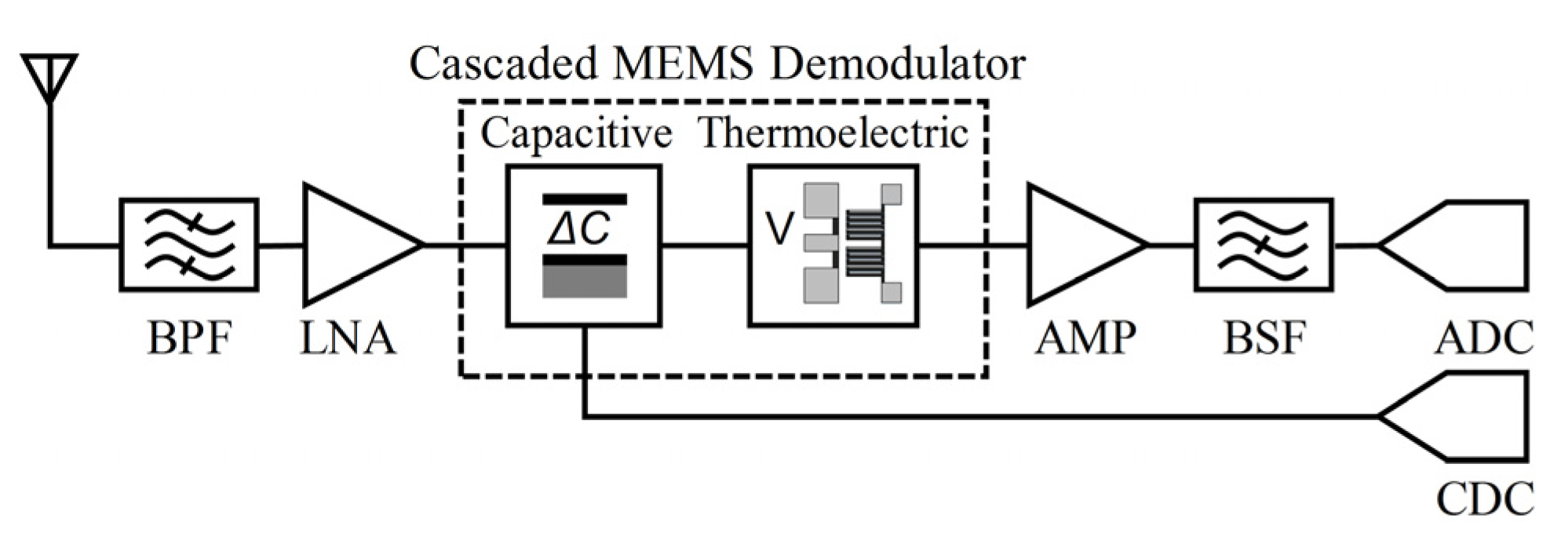
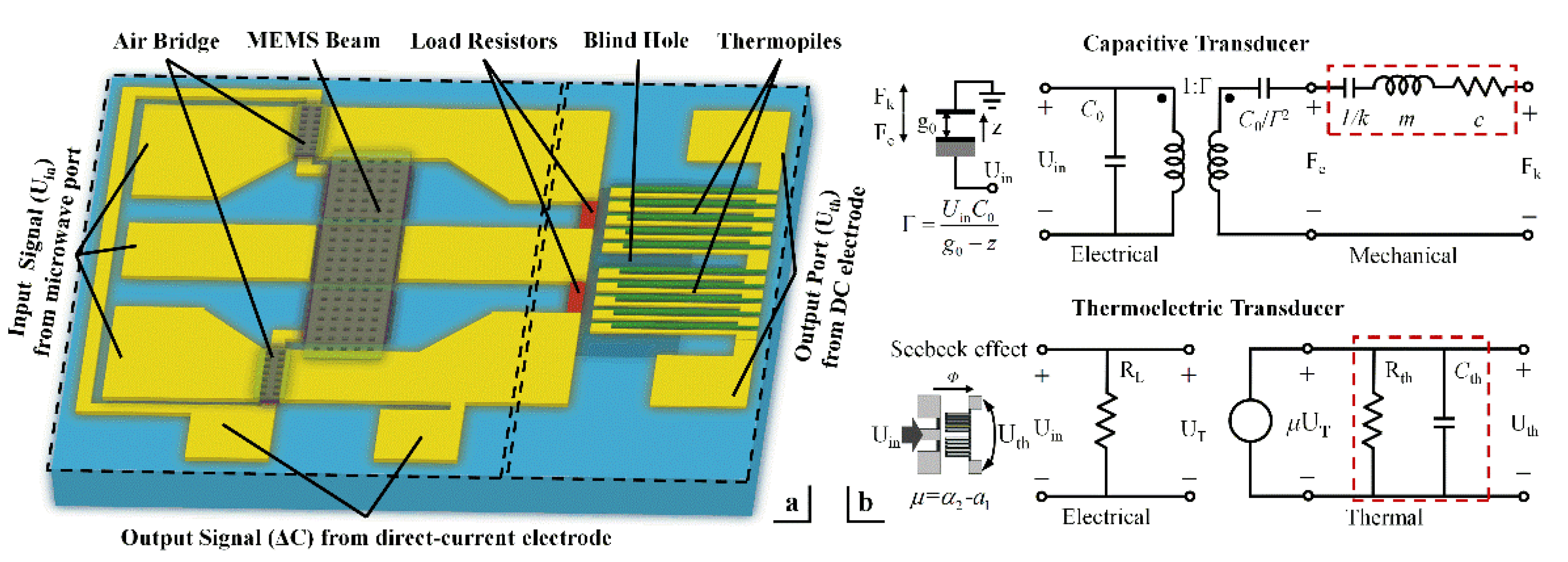
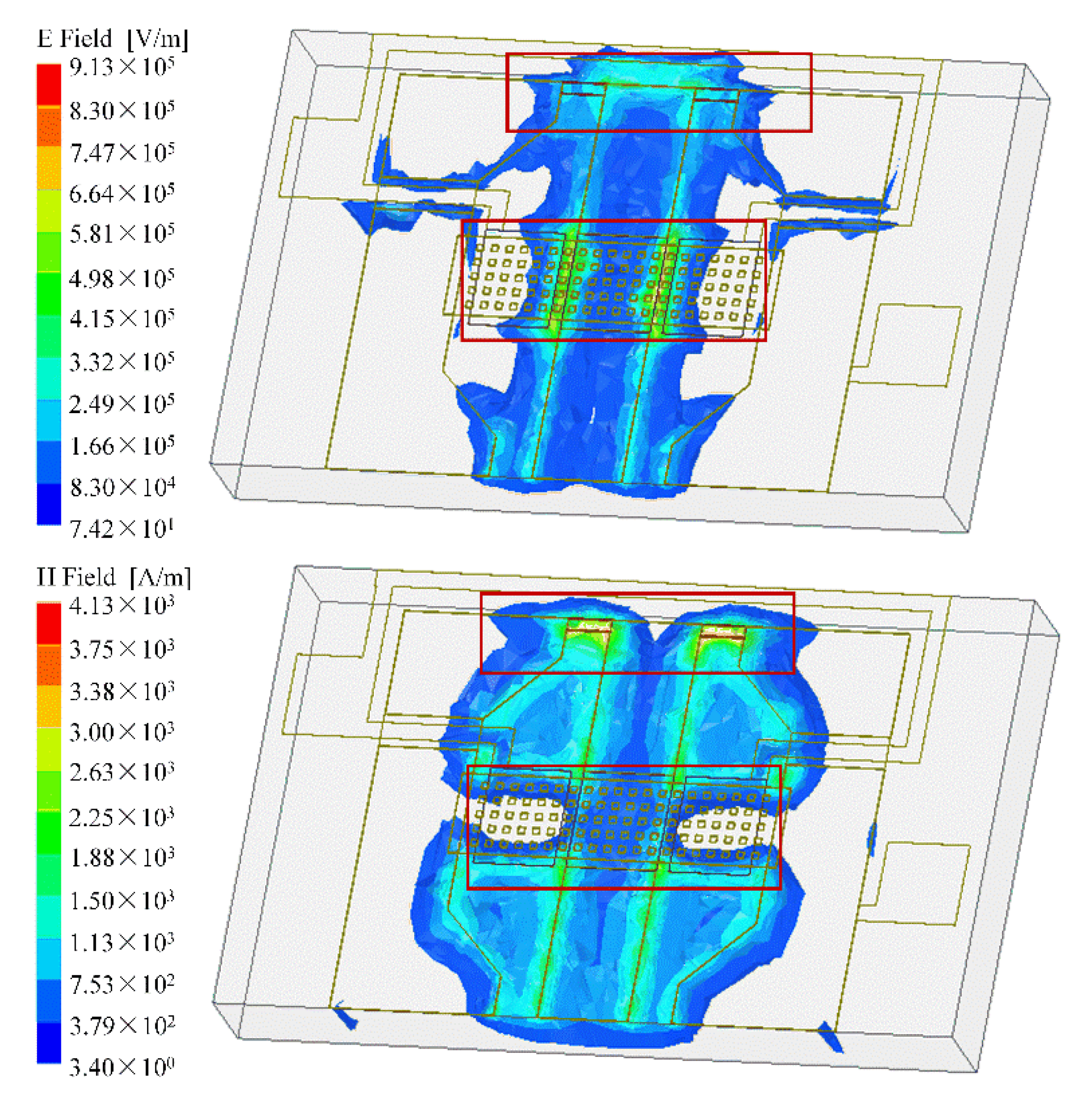
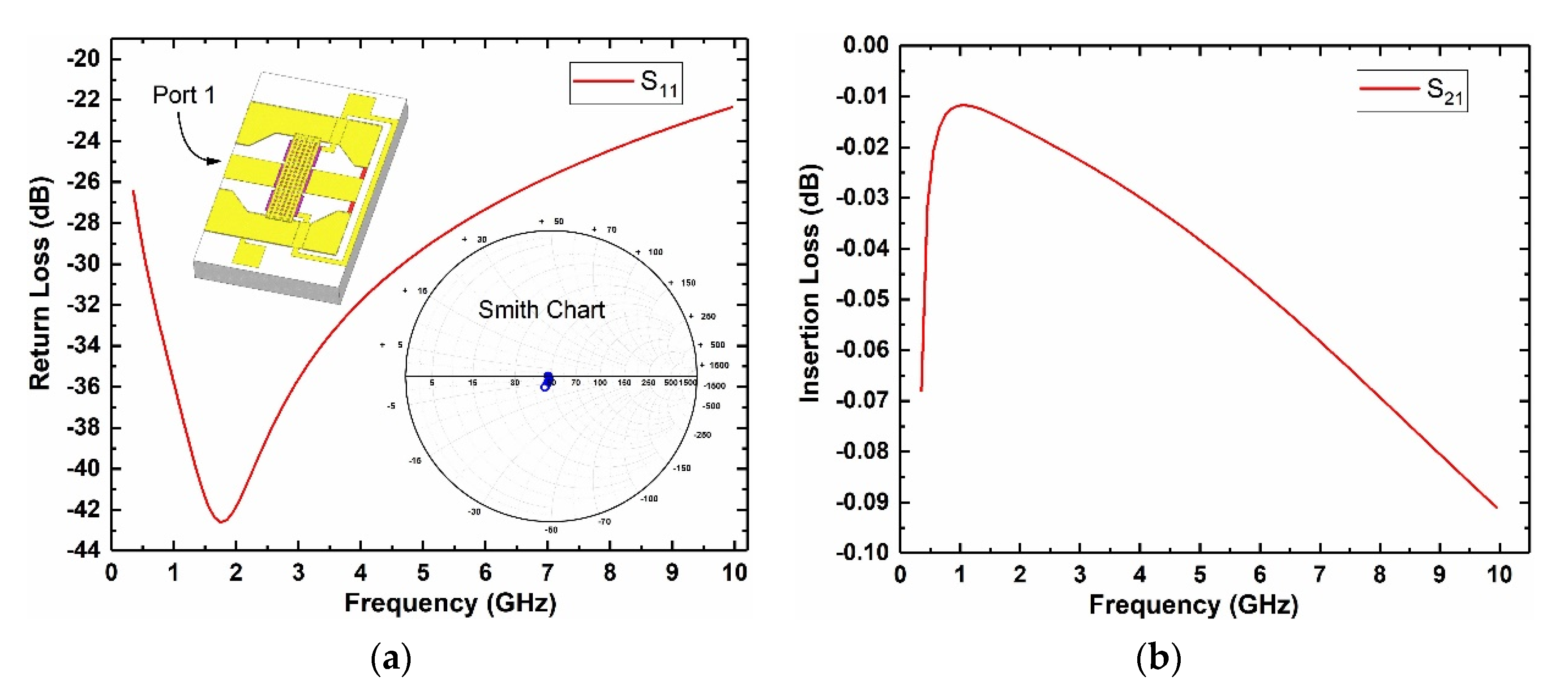
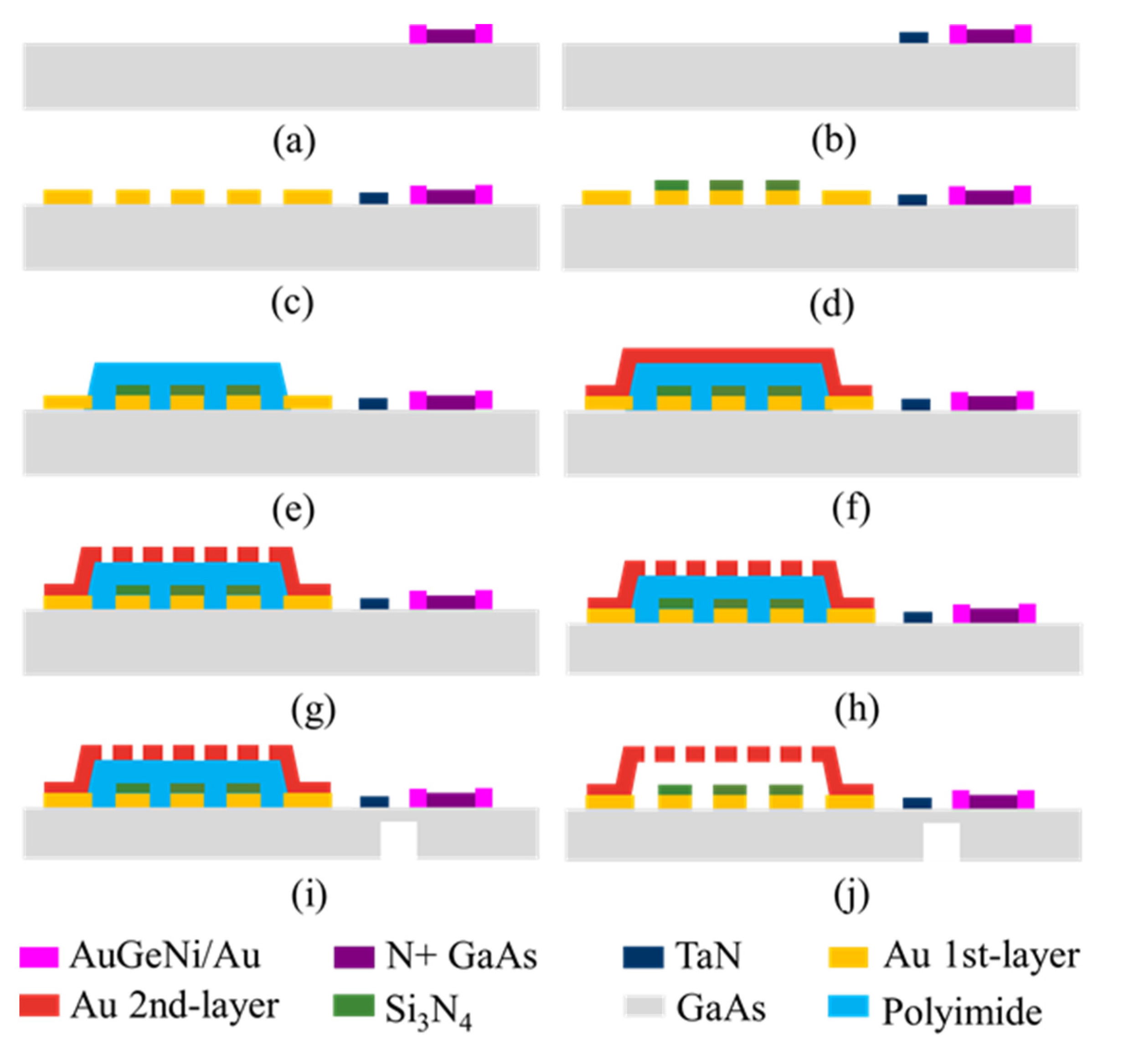

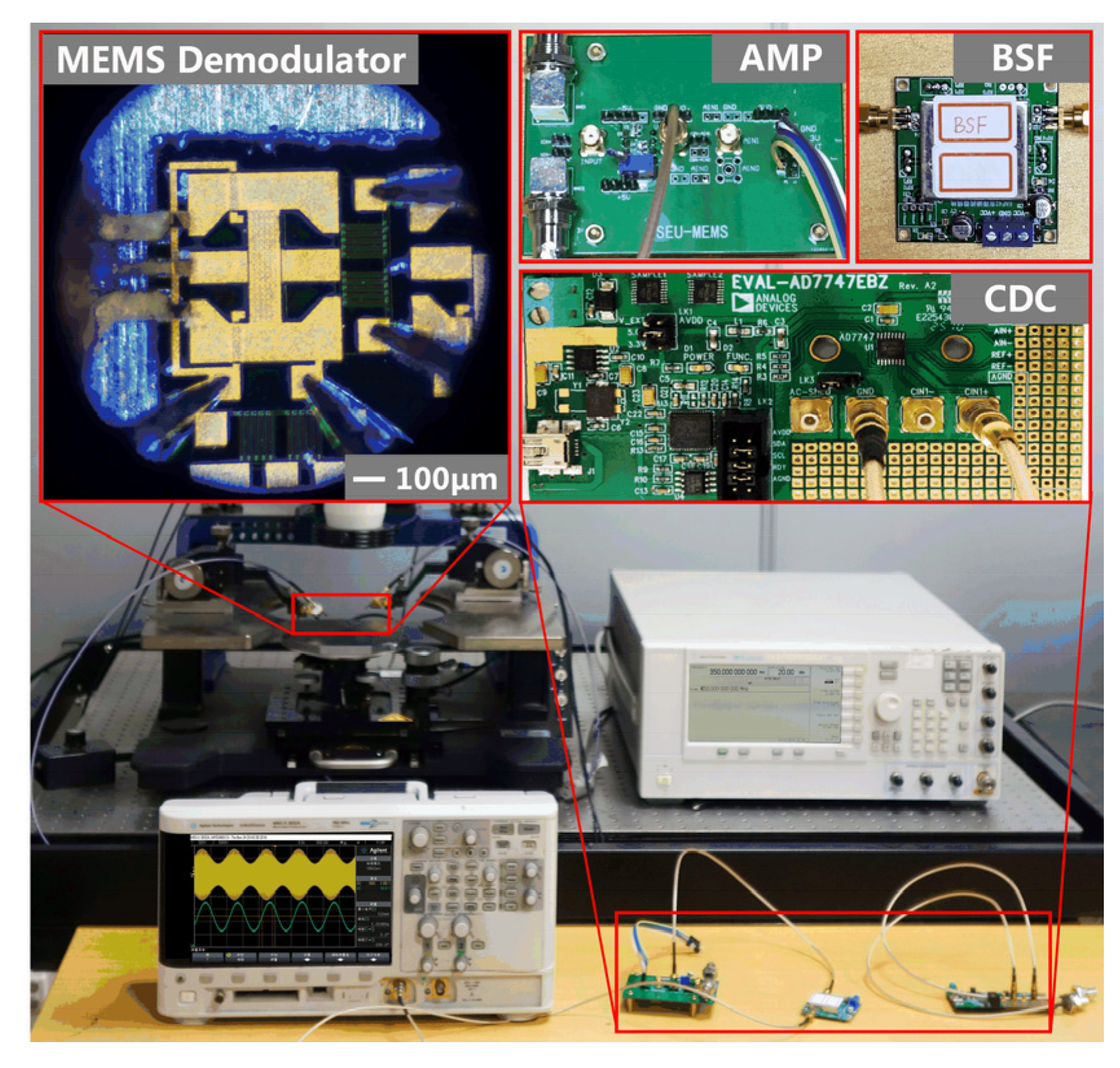
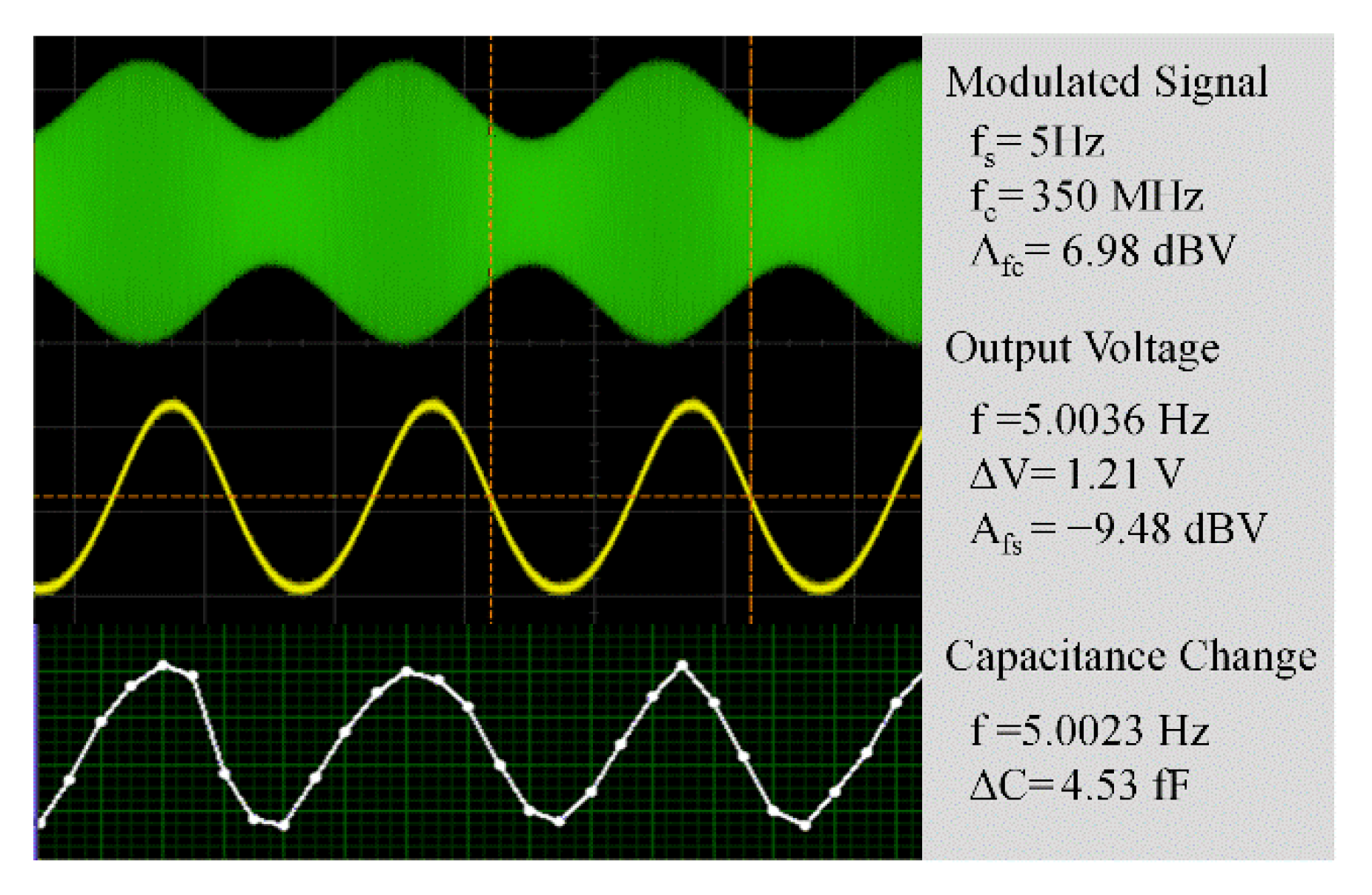
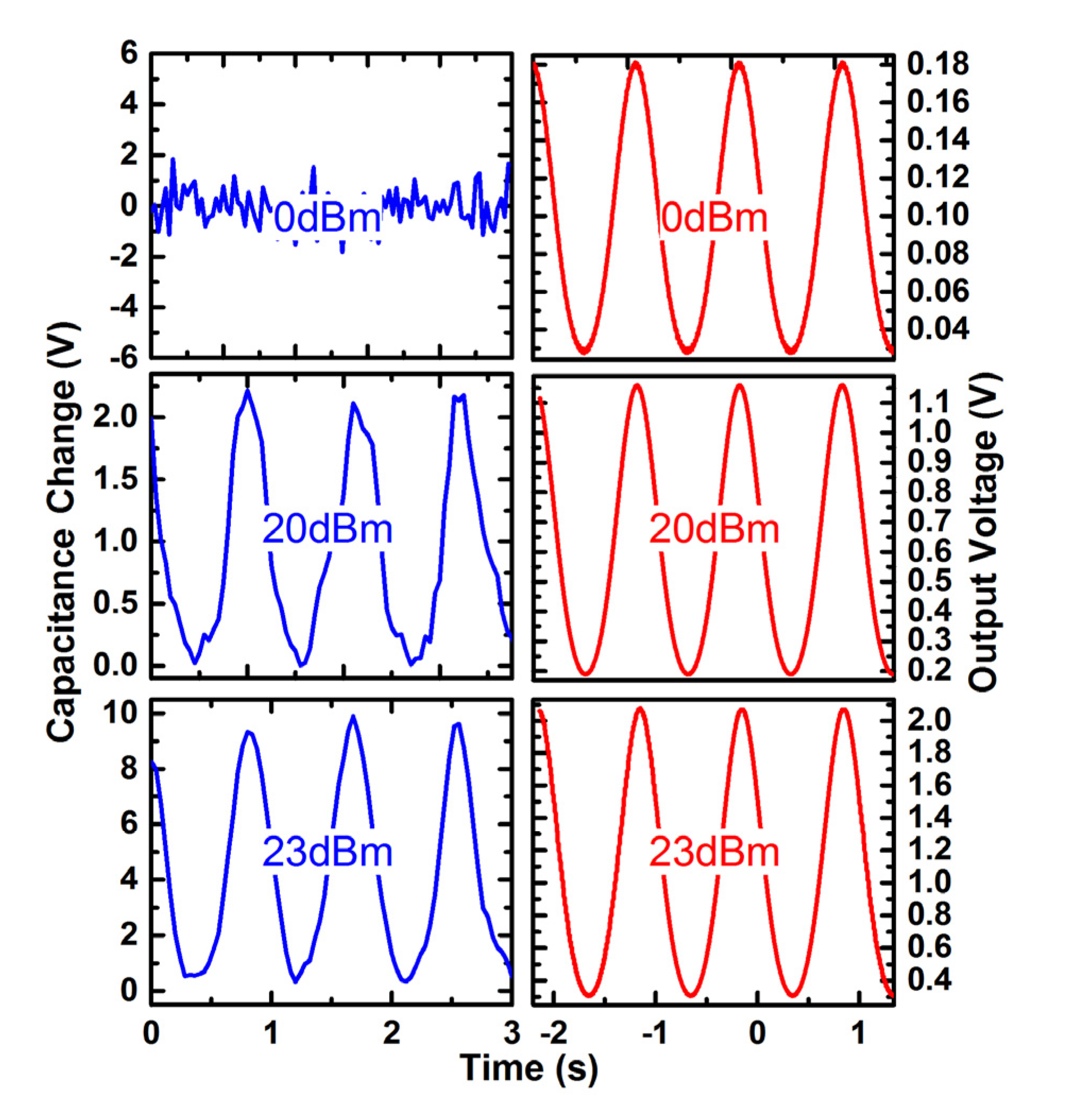
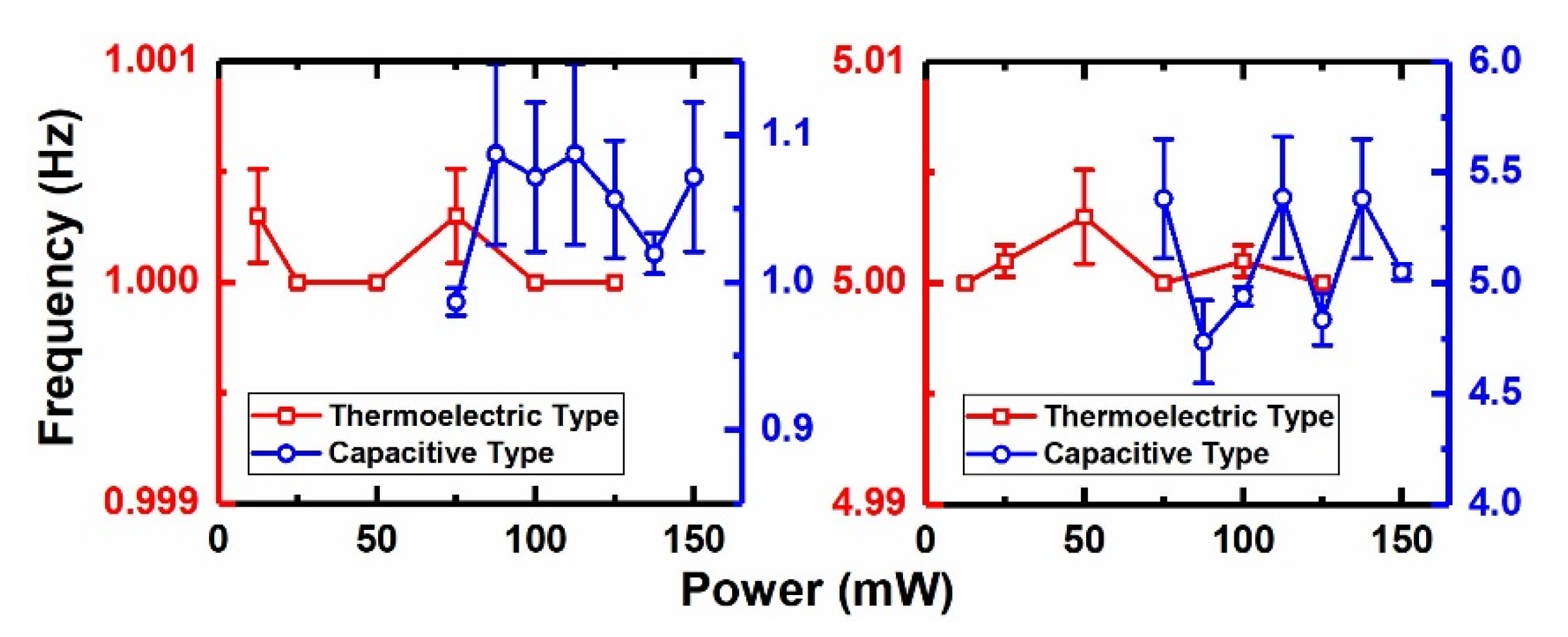
| Quantity | Value |
|---|---|
| Width of main CPW signal line | 100 μm |
| Gap between ground and CPW signal line | 58 μm |
| Width of ground line | 300 μm |
| Width of the clamped beam | 100 μm |
| Length of the clamped beam | 400 μm |
| Height of the air-gap | 1.6 μm |
| Size of the thin-film resistor | 14.5 μm × 58 μm |
| Size of the air bridge | 120 μm × 40 μm |
| Thickness of dielectric layer | 0.23 μm |
| Thickness of ground & CPW signal line | 2.4 μm |
Publisher’s Note: MDPI stays neutral with regard to jurisdictional claims in published maps and institutional affiliations. |
© 2021 by the authors. Licensee MDPI, Basel, Switzerland. This article is an open access article distributed under the terms and conditions of the Creative Commons Attribution (CC BY) license (https://creativecommons.org/licenses/by/4.0/).
Share and Cite
Yan, H.; Liao, X.; Li, C.; Chen, C. A Cascaded MEMS Amplitude Demodulator for Large Dynamic Range Application in RF Receiver. Micromachines 2021, 12, 1515. https://doi.org/10.3390/mi12121515
Yan H, Liao X, Li C, Chen C. A Cascaded MEMS Amplitude Demodulator for Large Dynamic Range Application in RF Receiver. Micromachines. 2021; 12(12):1515. https://doi.org/10.3390/mi12121515
Chicago/Turabian StyleYan, Hao, Xiaoping Liao, Chenglin Li, and Chen Chen. 2021. "A Cascaded MEMS Amplitude Demodulator for Large Dynamic Range Application in RF Receiver" Micromachines 12, no. 12: 1515. https://doi.org/10.3390/mi12121515
APA StyleYan, H., Liao, X., Li, C., & Chen, C. (2021). A Cascaded MEMS Amplitude Demodulator for Large Dynamic Range Application in RF Receiver. Micromachines, 12(12), 1515. https://doi.org/10.3390/mi12121515






